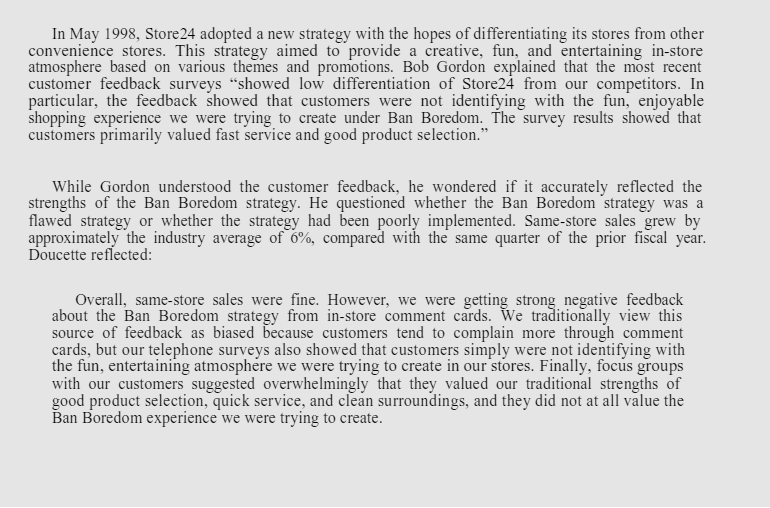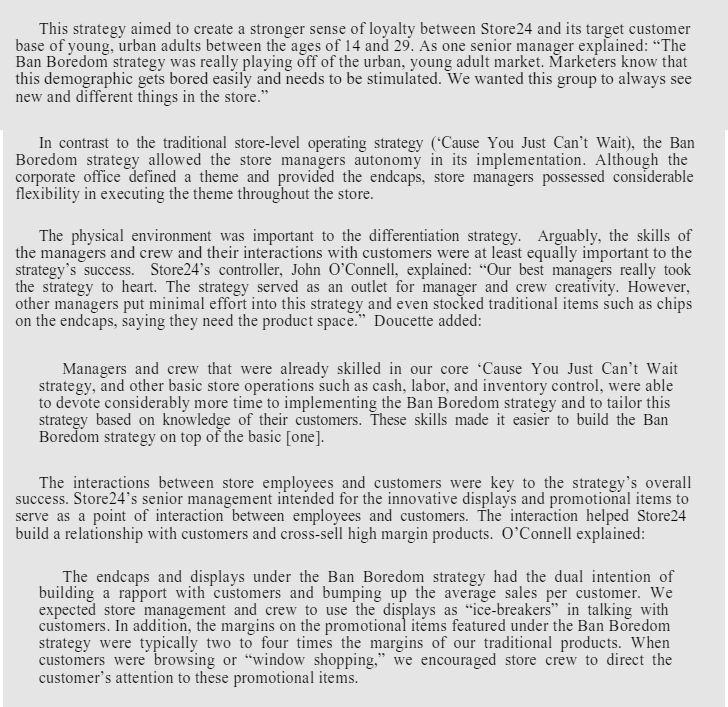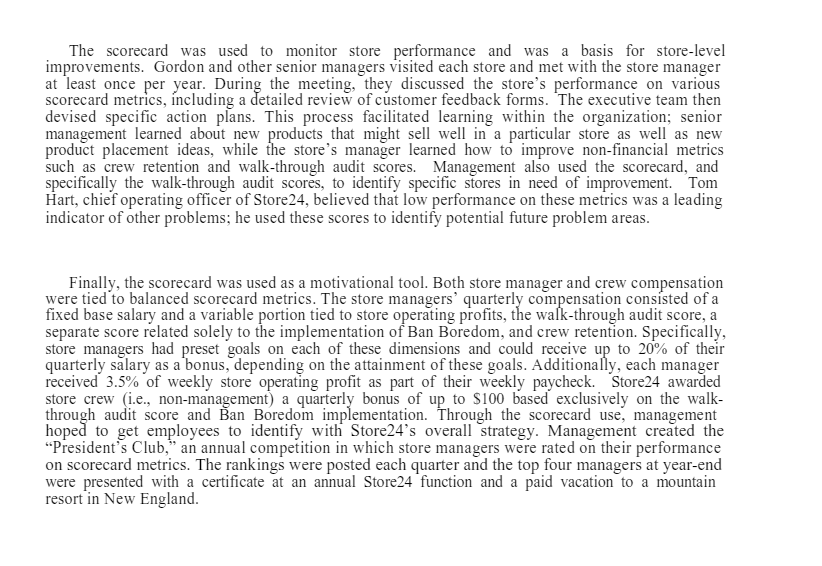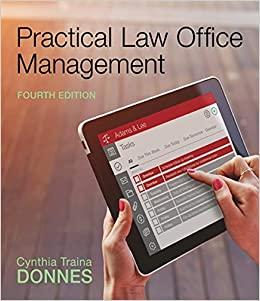How can we use the measurement system to determine if Ban the Boredom is a bad strategy or is poorly implemented?If you were Bob Gordon, what would you do , why?You have three choices:
- Drop Ban the Boredom
- Retain Ban the Boredom
- Keep Ban the Boredom in some stores
In May 1998, Store24 adopted a new strategy with the hopes of differentiating its stores from other convenience stores. This strategy aimed to provide a creative, fun, and entertaining instore atmosphere based on various themes and promotions. Bob Gordon explained that the most recent customer feedback surveys \"showed low differentiation of Store24 from our competitors. In particular, the feedback showed that customers were not identifying with the m, enjoyable shopping experience we were trying to create under Ban Boredom. The survey results showed that customers primarily valued fast service and good product selection." While Gordon understood the customer feedback, he wondered if it accurately reected the strengths of the Ban Boredom strategy. He questioned whether the Ban Boredom strategy was a flawed strategy or whether the strategy had been poorly implemented. Samestore sales grew by approximately the industry average of 6%, compared with the same quarter of the prior scal year. Doucette reected: Overall, samestore sales were ne. However, we were getting stro negative feedback about the Ban Boredom strategy from instore comment cards. We 'tionally view this source of feedback as biased because customers tend to complain more through comment cards, but our telephone surveys also showed that customers simply were not identifying with the m, entertaining atmosphere we were trying to create in our stores. Finally, focus groups with our customers suggested overwhelmingly that they valued our traditional strengths of good product selection, quick service, and clean surroundings, and they did not at all value the Ban Boredom experience we were trying to create. Store24's Performance Measurement System Store24 's Balanced Scorecard Store24's performance measurement system consisted primarily of a Balanced Scorecard (presented, with metric denitions, in Exhibit 3). As part of its Balanced Scorecard, Store24 collected information on a variety of performance measures at various levels of the organization and at various frequencies throughout the year. Store24 collected storelevel nancial performance metrics on a quarterly basis. These metrics included sales, margin, controllable contribution, and earnings before interest and taxes. Additionally, customer volume was measured quarterly. Semiannually, a thirdparty research rm conducted telephone surveys of selfidentied convenience store customers in Store24's major markets. Survey items included the likelihood of shopping at Store24 rather than its competitors, name recognition of Store24 versus its competitors, and for customers 'dtat had shopped at Store24 recently, ratings of quality of merchandise, price, and cleanliness of the store. Additionally, Store24 solicited feedback via instore comment cards from its customers about the product selection and other factors that would persuade them to shop at Store24. Store24 translated its two strategies into a set of storelevel operating standards. Management measured storelevel conformance with these standards dirough detailed walkthrough audits. During these announced visits, management evaluated the store's performance on various dimensions, including instore image, instock position, and store appearance. The walkthrough audit score quantied the storelevel implementation of Store24's operating strategy. Starting in May [998, die standards reflected both components of the storelevel strategy. Senior and division management considered employee skills critical for consistent implementation of le storelevel operating strategy. Accordingly, Store24 measured manager and crew skills through biannua] evaluations. Finally, Store24 tracked metrics related to its store locations. The measures included 'le number of competing stores within a half-mile radius, the foot trafc, the population density within a halfmile radius, the population within a halfmile radius (divided into prohigh school students, high school students, and college students), the median household income within a halfmile radius, and the percentage of the population within a half-mile radius that held whitecollar jobs. Uses ofrhe Balanced Scorecard Through the Balanced Scorecard. management communicated Store24's operating strategy to employees throughout the organization. The measures and the links between these measures illustrated the qualitative impact that improving a given metric would have on overall company performance. The scorecard served as due centerpiece for quarterly meetings of die senior management team {i.e., corporatelevel and division managers). Each quarter, overall performance on the different perspectives was given a grade of A+f, B+f, C+f, D+.r', or F based on its relation to target. Deviations from the target, both positive and negative, were discussed during the meeting and areas for improvement were identied. This strategy aimed to create a stronger sense of loyalty between Store24 and its target customer base of young, urban adults between the ages of 14 and 29. As one senior manager explained: \"The Ban Boredom strategy was really playing off of the urban, young adult market. Marketers know that this demographic gets bored easily and needs to be stimulated. We wanted this group to always see new and different things in the store." In contrast to the traditional storelevel operating strategy {'Cause You Just Can't Wait), the Ban Boredom strategy allowed the store managers autonomy in its implementation. Although the corporate ofce dened a theme and provided the endcaps, store managers possessed considerable exibility in executing the theme throughout the store. The physical environment was important to the differentiation strategy. Arguably, the skills of the managers and crew and their interactions with customers were at least equally important to the strategy's success. Store24's controller, John O'Connell, explained: \"Our best managers really took the strategy to heart. The strategy served as an outlet for manager and crew creativity. However, other managers put minimal effort into this strategy and even stocked traditional items such as chips on the endcaps, saying they need the product space." Doucette added: Managers and crew that were already skilled in our core 'Cause You Just Can't Wait strategy, and other basic store operations such as cash, labor, and inventory control, were able to devote considerably more time to implementing the Ban Boredom strategy and to tailor this strategy based on knowledge of their customers. These skills made it easier to build the Ban Boredom strategy on top of the basic [one]. The interactions between store employees and customers were key to the strategy's overall success. Store24's senior management intended for the innovative displays and promotional items to serve as a point of interaction between employees and customers. The interaction helped Store24 build a relationship with customers and cross~sell high margin products. O'Connell explained: The endcaps and displays under the Ban Boredom strategy had the dual intention of building a rapport with customers and bumping up the average sales per customer. We expected store management and crew to use the displays as \"ice-breakers" in talking with customers. In addition, the margins on the promotiona items featured under the Ban Boredom strategy were typically two to four times the margins of our traditional products. When customers were browsing or \"window shopping," we encouraged store crew to direct the customer's attention to these promotional items. The scorecard was used to monitor store performance and was a basis for store-level improvements. Gordon and other senior managers visited each store and met with the store manager at least once per year. During the meeting, they discussed the store's performance on various scorecard metrics, including a detailed review of customer feedback forms. The executive team then devised specific action plans. This process facilitated learning within the organization; senior management learned about new products that might sell well in a particular store as well as new product placement ideas, while the store's manager learned how to improve non-financial metrics such as crew retention and walk-through audit scores. Management also used the scorecard, and specifically the walk-through audit scores, to identify specific stores in need of improvement. Tom Hart, chief operating officer of Store24, believed that low performance on these metrics was a leading indicator of other problems; he used these scores to identify potential future problem areas. Finally, the scorecard was used as a motivational tool. Both store manager and crew compensation were tied to balanced scorecard metrics. The store managers' quarterly compensation consisted of a fixed base salary and a variable portion tied to store operating profits, the walk-through audit score, a separate score related solely to the implementation of Ban Boredom, and crew retention. Specifically, store managers had preset goals on each of these dimensions and could receive up to 20% of their quarterly salary as a bonus, depending on the attainment of these goals. Additionally, each manager received 3.5% of weekly store operating profit as part of their weekly paycheck. Store24 awarded store crew (i.e., non-management) a quarterly bonus of up to $100 based exclusively on the walk- through audit score and Ban Boredom implementation. Through the scorecard use, management hoped to get employees to identify with Store24's overall strategy. Management created the "President's Club," an annual competition in which store managers were rated on their performance on scorecard metrics. The rankings were posted each quarter and the top four managers at year-end were presented with a certificate at an annual Store24 function and a paid vacation to a mountain resort in New England










